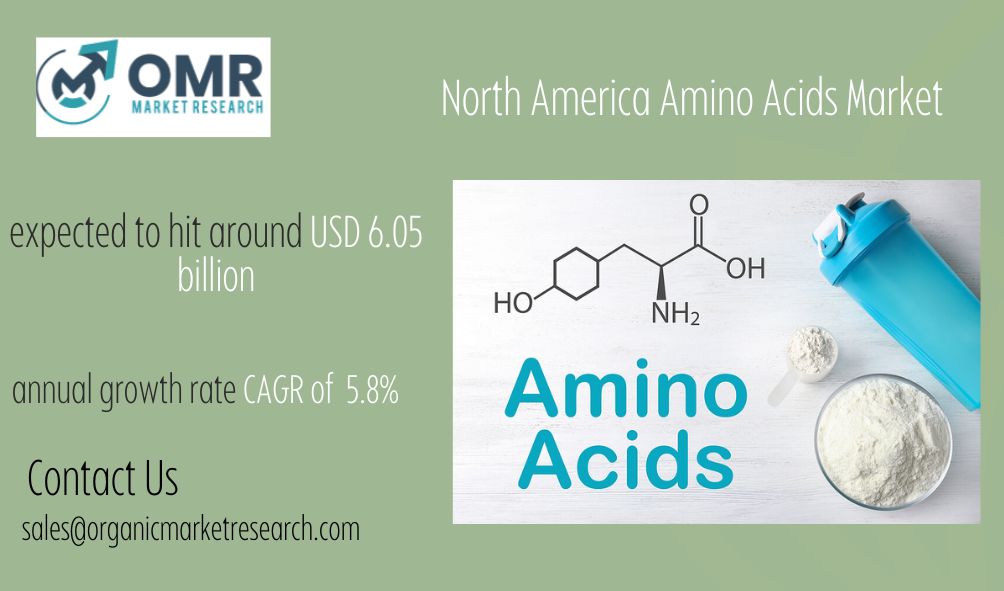North America Amino Acids market size was USD 6.05 billion in 2023 and the market is projected to touch USD 10.05 billion by 2032, at a CAGR of 5.8 % during the forecast period. Amino acids play a vital role in functions such as muscle growth, tissue repair, and hormone balance. They are used in various industries like food, pharmaceuticals, and animal feed. The market includes natural amino acids sourced from foods like meat, eggs, and dairy, as well as synthetic ones made through chemical methods.
Over the past few years, the North American Amino Acids market has seen consistent growth due to growing demand across different industries. The food and beverage sector has played a major role in driving this growth, as amino acids are commonly used as additives to boost flavour, texture, and nutritional benefits. Furthermore, amino acids are essential for drug and supplement production in the pharmaceutical industry, targeting various health concerns. Amino acids also play a key role in enhancing the quality and nutritional value of livestock feed in the animal feed industry. Due to improvements in biotechnology and manufacturing, the market is set to grow even more, creating probabilities for new ideas and investments in the area.
North America Amino Acids report scope and segmentation.
North America Amino Acids dynamics
The Amino Acids market in North America is influenced by various factors that affect both supply and demand in the region. A key factor is the increasing focus on health and wellness among consumers, which has led to a higher demand for dietary supplements and fortified foods that contain amino acids. Additionally, the growing incidence of lifestyle-related diseases and an aging population have fuelled the need for pharmaceuticals and functional foods that are enriched with amino acids to manage conditions like diabetes, obesity, and cardiovascular diseases.
The development of biotechnology and manufacturing processes has helped produce amino acids faster and cheaper, leading to increased production and competition. This has sparked innovation and product development in the market. Regulatory efforts to promote sustainability and product safety are also impacting the market, with companies prioritizing quality and environmental compliance.
North America Amino Acids drivers
Growing Health Awareness
The growing understanding of the significance of health and wellness among consumers is a key factor driving the North America Amino Acids market. As individuals become more aware of the impact of nutrition on overall well-being, there is an increasing desire for dietary supplements and functional foods that contain amino acids. Consumers are looking for products that provide specific health advantages, like promoting muscle recovery, aiding immune function, and enhancing cognitive performance, which is driving the popularity of amino acid-infused products. This movement is also influenced by a preference for natural and transparent labelling, prompting manufacturers to innovate new sources and compositions of amino acids to cater to consumer demands.
Expansion of Pharmaceutical Applications
The pharmaceutical industry is increasingly turning to amino acids for drug development, which is a major factor driving market growth. Amino acids are crucial for producing proteins and peptides, essential elements in numerous pharmaceutical products used to treat diseases like cancer, diabetes, and infections. With ongoing innovations in biotechnology and drug delivery methods, there is a rising trend towards utilizing amino acid-based treatments and formulas for more precise drug delivery, enhanced absorption, and minimized adverse effects. The widening range of uses for amino acids offers a chance for amino acid producers to work together with pharmaceutical firms in creating groundbreaking products to meet medical needs that have not been addressed yet, which will help boost the market.
- Restraints:
Price Volatility of Raw Materials
The Amino Acids market in North America is encountering issues with the fluctuating prices of raw materials. Amino acids, which are mainly sourced from soybeans, corn, and wheat, are affected by changes in supply and demand, as well as external factors like weather and geopolitical tensions. These fluctuations can cause disruptions in supply chains, leading to changes in production costs that affect manufacturers’ profits and the pricing of amino acid products. Also, the market’s reliance on agricultural goods makes it vulnerable to risks like crop failures, trade conflicts, and regulatory shifts, underscoring the need for risk management plans and diversification of supply sources.
Stringent Regulatory Requirements
Government regulations in North America are putting restrictions on the Amino Acids market. Amino acids are essential in food additives, dietary supplements, and pharmaceuticals, all of which have stringent safety and quality standards to protect consumers. Following rules like Good Manufacturing Practices (GMP), proper labelling, and limits on contaminants can be costly and burdensome for manufacturers. In addition, the rules and regulations are always changing, with ongoing updates and changes that industry participants need to keep a close eye on and adjust to. This can sometimes slow down-market growth and innovation.
- Opportunities:
Rising Demand for Plant-Based Amino Acids
The increasing popularity of plant-based diets is creating a new opportunity in the North American Amino Acids market. More and more consumers are looking for plant-based alternatives to animal products for their health, the environment, and ethical reasons. This has led to a growing demand for plant-based amino acids sourced from plants like soy, peas, and algae. To take advantage of this trend, manufacturers can focus on creating sustainable and scalable methods for producing plant-based amino acids and incorporating them into various food, beverage, and nutritional products aimed at vegan and vegetarian consumers.
- Segment Overview
By Product Category, North America Amino Acids market is segmented into microbial amino acids, plant-based amino acids, and synthetic amino acids, each catering to diverse end-use sectors. Microbial amino acids produce through fermentation processes, using bacteria and yeast, which have benefits like being scalable, sustainable, and pure. Plant-based amino acids come from sources like soy, peas, and algae, and are popular among consumers looking for vegan and vegetarian options in food, supplements, and personal care products. Synthetic amino acids, made through chemical processes, provide flexibility and customization for industrial uses such as pharmaceuticals, food additives, and animal feed.
By Application, the North America Amino Acids market is segmented into pharmaceuticals, dietary supplements, animal feed, food and beverages, sports nutrition, cell culture media, cosmetics, and personal care products. Amino acids play a crucial role in the pharmaceutical sector, being used in drug formulations to treat diseases, improve drug delivery, and support metabolic processes. They are also popular ingredients in dietary supplements, promoting muscle growth, boosting energy metabolism, and overall health and wellness. Amino acids are incorporated into animal feed formulations to enhance feed efficiency, improve growth performance, and increase nutrient utilization in livestock production. In the food and beverage industry, amino acids serve as flavour enhancers, nutritional additives, and functional ingredients in a wide range of products such as protein bars, sports drinks, and fortified beverages. Nutritional supplements for athletes and fitness enthusiasts use amino acids to aid in muscle recovery, improve endurance, and enhance performance. Amino acids are also crucial components in the development of cell culture media for biopharmaceutical manufacturing, as well as in skincare and haircare products for their beneficial effects.
North America Amino Acids Overview by Region
The United States is the leader in the North America Amino Acids market, being the biggest consumer and producer due to its strong pharmaceutical, food and beverage, and animal feed industries. The country’s impressive research and development infrastructure, technological advancements, and supportive regulatory framework all play a role in driving market expansion and fostering innovation. Canada also holds a substantial portion of the market, propelled by its growing pharmaceutical and food processing industries, while Mexico shows potential with rising investments in manufacturing and agriculture. The increasing focus on health and wellness in the region, along with a growing interest in functional and fortified products, is driving the use of amino acids in various applications. Even with challenges like fluctuating raw material prices and stringent regulatory rules, market players are taking strategic actions to manage risks and take advantage of growth prospects.
North America Amino Acids market competitive landscape
Leading companies such as Ajinomoto Co., Inc., ADM, CJ CheilJedang Corporation, and Evonik Industries AG dominate the market with their extensive product portfolios and regional presence. Companies in this industry prioritize innovation, constantly working on new ways to use amino acids in various sectors that align with consumer demands and industry changes. Partnering with research institutions and academic organizations helps them pool resources and knowledge to improve their products and technology. Mergers and acquisitions also play a role in expanding market reach, strengthening market presence, and boosting competitiveness. With increased competition, businesses are focusing on sustainability, quality assurance, and regulatory compliance to build and maintain consumer trust in the competitive North America Amino Acids market.
North America Amino Acids Recent Developments
- Oct 2022, a collaboration was forged between Evonik and BASF, granting Evonik specific non-exclusive licensing privileges to OpteinicsTM. This digital solution aims to enhance understanding and minimize the environmental footprint of the animal protein and feed industries
- Dec 2021, Bayer launched Ambition, the inaugural amino acid biostimulant, into the Chinese market. This product explores the agricultural growth potential, promoting vigorous crop growth coupled with robust stress resistance to achieve high yields and superior quality. It offers benefits to farmers in terms of improved harvests, soil preservation, and consumer safety, making it suitable for organic farming practices.
Scope of North America Amino Acids report
In case you don’t find what, you are looking for, please get in touch with our custom research team at
Latest Report
https://organicmarketresearch.com/press-release/saudi-arabia-influenza-vaccine-market
https://organicmarketresearch.com/press-release/saudi-arabia-smart-meters-market
https://organicmarketresearch.com/press-release/saudi-arabia-in-vitro-diagnostics-market
https://organicmarketresearch.com/press-release/uae-green-energy-market
Contact Us
+91 9319642100
sales@organicmarketresearch.com
Noida One Tower Sec 62 Noida 201301
Website: https://organicmarketresearch.com












